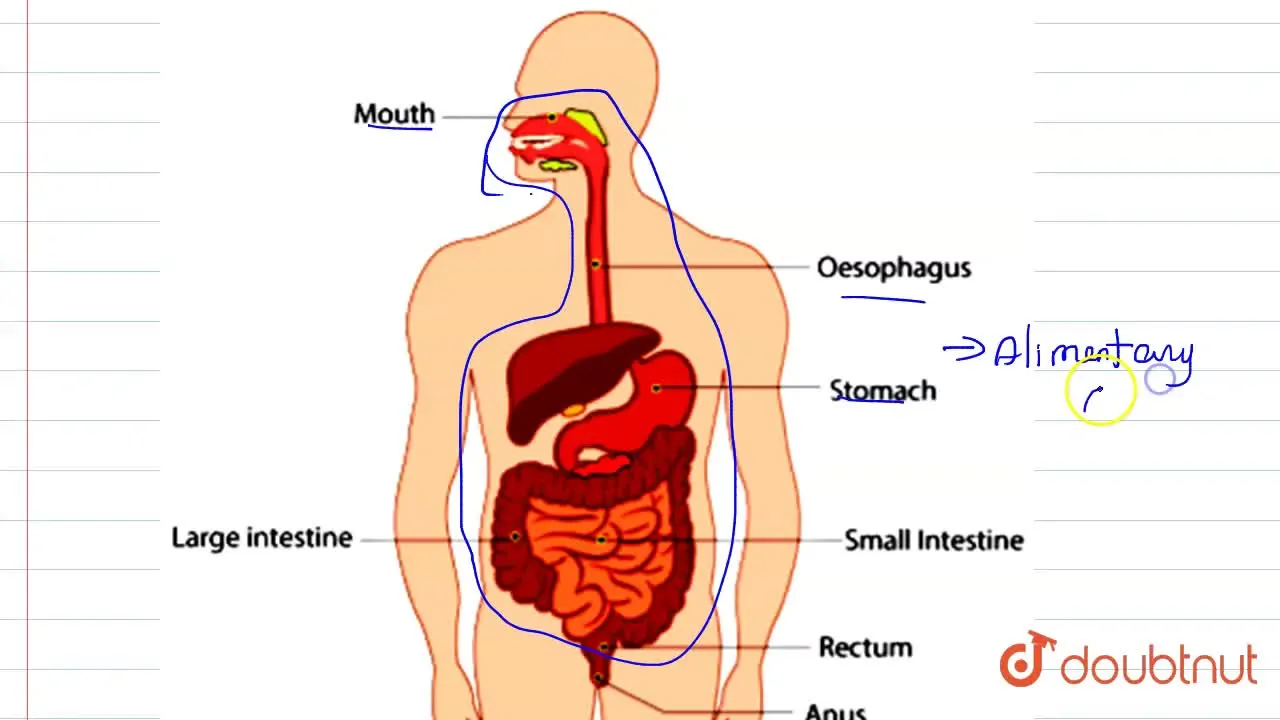Describe the alimentary canal of man.Solution in Tamil
Alimentary canal (digestive tract/gastro-intestinal tract) :
The glands associated with the digestive system are the salivary glands, gastric glands, pancreas, liver and intestinal gland.

Structure of the Alimentary Canal :
Alimentary canal is a muscular coiled, tubular structure. It consistss of mouth, buccal cavity, pharynx, oesophagus, stomach, small intestine (consisting of duodenum, jejunum and ileum), large intestine (consisting of caecum, colon and rectum) and anus.
Mouth : The mouth leads into the buccal cavity. It is bound by two soft, movable upper and lower lips. The buccal cavity is a large space bound above by the palate (which separates the wind pipe and food tube), below by the throat and on the sides by the jaws. The jaws bear teeth.
Teeth : Teeth are hard structures meant for holding, cutting, grinding and crushing the food. In human beings two sets fo teeth (Diphyodont) are developed in their life time. The first appearing set of 20 teeth called temporary or milk teeth are replaced by the second set of thirty two permanent teeth, sixteen in each jaw. Each tooth has a root fitted in the gum (theocodont). Permanent teeth are of four types (Heterodont), according to their structure and function namely incisors, canines, premolars and molars.
Salivary glands : Three pairs of salivary glands are present in the mouth cavity. They are : parotid glands, sublinglual glands and submaxillary or submandibular glands.
(i) Parotid glands are the largest salivary glands, which lie in the cheeks in front of the ears (in Greek Par - near, otid - ear).
(ii) Sublingual glands are the smallest glands and lie beneath the tongue.
(iii) Submaxillary or Submandibular glands lie at the angles of the lower jaw.
The salivary glands secrete a viscous fluid called saliva, approximately 1.5 liters per day. It digests starch by the action of the enzyme ptyalin (amylase) in the saliva which converts starch (polysaccharide) into maltose (disaccharide). Saliva also contain an antibacterial enzyme called lysozyme.
Tongue : The tongue is a muscular, sensory organ which helps in mixing the food with the saliva. The taste buds on the tongue help to recognize the taste of food.
The masticated food in the buccal cavity becomes a bolus which is rolled by the tongue and passed through pharynx into the oesophagus by swallowing. During swallowing, the epiglottis (a muscular flap-like structure at the tip of the glottis, beginning of trachea) closes and prevents the food from entering into trachea (wind pipe).
Pharynx is a membrance lined cavity behind the nose and mouth, connecting them to the oesophagus. It serves as a pathway for the movement of food from mouth to oesophagus.
Oesophagus or the food pipe is a muscular-membranous canal about 22 cm in length. It conduts food from pharynx to the stomach by peristalsis (wave-like movement) produced by the rhythmic contraction and relaxation of the muscualr walls of alimentary canal.
Stomach is a wide J-shapeed muscular organ located between oesophagus and the small intestine. The gastric glands present in the inner walls of the stomach secrete gastric juice. The gastric juice is colourless, highly acidic, containing mucus, hydrochloric acid and enzymes remain (in infants) and pepsin.
Small intestine is the longest part of the alimentary canal, which is a long coiled tube measuring about 5-7 m. It comprises three parts-duodenum, jejunum and ileum.
1. Duodenum is C-shaped and receives the bile duct (from liver) and pancreatic duct (from pancreas).
2. Jejunum is the middle part of the small intestine. It is a short region of the small intestine. The secretion of the small intestine is intestinal juice which contains the enzymes like sucrase, maltase, lactase and lipase.
3. Ileum forms the lower part of the small intestine and opens into the large intestine. Ileum is the longest part of the small intestine. It contains minute finger like projections called villi (one millimeter in length) where absorption of food takes place. They are approximately 4 million in number. Internally, each villus contains fine blood capillaries and lacteal tubes.
The small intestine serves both for digestion and absorption. It receives (i) the bile from liver and (ii) the pancreatic juice from pancreas in the duodenum. The intestinal glands secrete the intestinal juices.
Liver is the largest digestive gland of the body which is rddish brown in colour. It is divided into two main lobes, right and left lobes. The right lobe is large than the left lobe. On the under surface of the liver, gall bladder is present. The liver cells secrete bile which is temporarily stored in the gall bladder.
Pancreas is a lobed, leaf shaped gland situated between the stomach and duodenum. Pancreas acts both as an exocrine gland and as an endocrine gland. The gland.s upper surface bears the isletes of Langerhans which have endocrine cells and secrete hormones in which (alpha) cells secrete glucagon and (beta) cells secrete insulin.
The intestinal glands intestinal juice called succusentericus which contains enzymes like maltase, lactase sucrase and lipase which act in an alkaline medium. From the duodenum the food is slowly moved down to ileum, where the digested food gets absorbed
Large intestine
The unabsorbed and undigested food is passed into the large intestine. It extends from the ileum to the anus. It is about 1.5 meters in length. It has three parts-caecum, colon and rectum.
The caecum is a small blind pouch like structure situated at the junction of the small and large intestine. From its blind end a finger - like structure called vermiform appendix arises. It is a vestigeal (functionless) organ in human beings.
The colon is much broader than ileum. It passes up the abdomen on the right (asccending colon), crosses to the left just below the stomach (transverse colon) and down on the left side (descending colon).
The rectumis the last part which opens into the anus. It is kept closed by a ring of muscles called anal sphincter which opens when passing stools.
Related Playlists
- BOOK - FULL MARKSCHAPTER - ORGAN SYSTEMS IN ANIMALSEXERCISE - EXERCISE - ASSERTION AND REASON2videos
ORGAN SYSTEMS IN ANIMALS
- BOOK - FULL MARKSCHAPTER - ORGAN SYSTEMS IN ANIMALSEXERCISE - EXERCISE - HIGHER ORDER THINKING SKILLS5videos
ORGAN SYSTEMS IN ANIMALS
- BOOK - FULL MARKSCHAPTER - ORGAN SYSTEMS IN ANIMALSEXERCISE - EXERCISE - ANSWER BRIEFLY6videos
ORGAN SYSTEMS IN ANIMALS
- BOOK - FULL MARKSCHAPTER - NUTRITION AND HEALTH EXERCISE - ADDITIONAL QUESTIONS (V. Answer the following in detail.)3videos
NUTRITION AND HEALTH
- BOOK - FULL MARKSCHAPTER - ORGANIZATION OF TISSUES EXERCISE - ADDITIONAL QUESTION LONG ANSWERS QUESTION4videos
ORGANIZATION OF TISSUES
Similar Questions
Assertion : Urea is excreted out through the kidneys
Reason : Urea is a toxic substance.01:50View SolutionIf pepsin is lacking in gasric juic, then which event in the stomach will be affected ?
a. Digestion of starch into sugars.
b. Breaking of proteins into peptides.
c. Digestion of nucleic acids.
d. Breaking of fats into glycerols and fatty acids.01:34View SolutionHow is the small intestine designed to absorb digested food ?
02:32View SolutionWhat is food spoilage? What are the factors responsible for food spoilage ?
02:20View SolutionGive notes on: (i) squamous epithelium, (ii) cuboidal epithelium, (iii) columnar epithelium (iv) ciliated epithelium and (v) glandular epithelium.
View Solutionमनुष्य के आहारनाल की लम्बाई कितनी होती है ?
02:20View Solutionमनुष्य के आहारनाल की लम्बाई कितनी होती है?
04:49View Solutionतिलचटटे की आहारनाल का सचित्र वर्णन कीजिए।
05:13View Solution________ is a vestigial organ in the alimentary canal of man .
01:21View Solutionआहारनाल में प्रोटीन के पाचन का क्रमवार वर्णन कीजिए।
02:01View SolutionIn which part of alimentary canal of man there is no perisataltic movement?
04:46View SolutionDescribe human alimentary canal . Draw a labelled diagram of human alimentary canal.
10:03View SolutionDescribe the human alimentary canal.
01:34View SolutionLength of alimentary canal of man is:
01:34View SolutionDescribe the alimentary canal of human being.
View Solutionमनुष्य के आहारनाल की रचना का वर्णन करें।
View Solution


